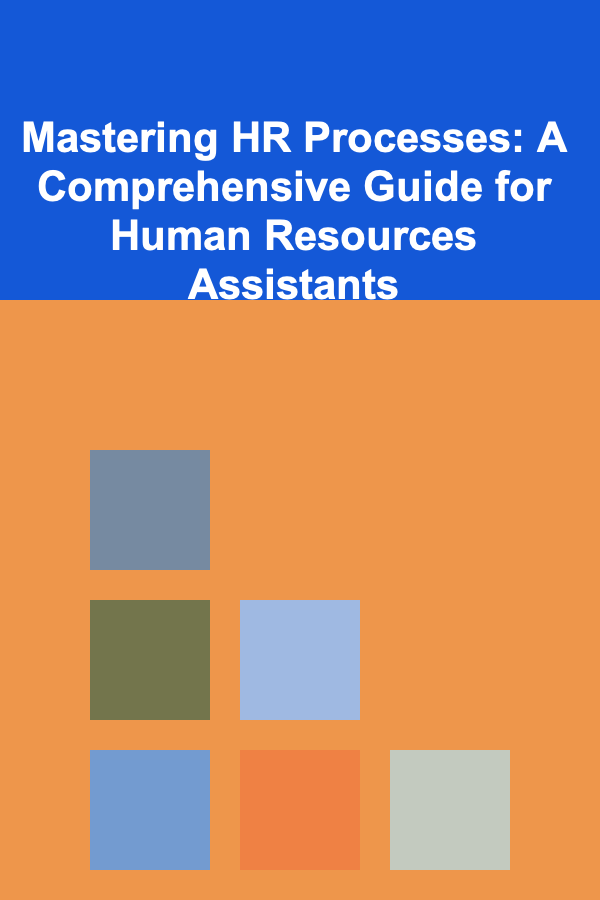
Mastering HR Processes: A Comprehensive Guide for Human Resources Assistants
ebook include PDF & Audio bundle (Micro Guide)
$12.99$11.99
Limited Time Offer! Order within the next:

Human Resources (HR) is the backbone of any organization, managing everything from recruitment to employee relations, compensation, training, and performance management. As an HR Assistant, your role is vital in ensuring these processes run smoothly and efficiently. HR processes not only contribute to the well-being of the employees but also play a significant role in the company's overall success. Mastering HR processes allows HR Assistants to manage the complexities of the workplace and contribute to an environment where employees can thrive.
This comprehensive guide provides actionable insights on mastering key HR processes, ensuring that HR Assistants can navigate their responsibilities with confidence, consistency, and expertise.
Recruitment and Onboarding: Laying the Foundation for Success
Recruitment and onboarding are among the most important HR processes. Efficient recruitment ensures that the organization attracts top talent, while an effective onboarding process helps new hires feel welcome, prepared, and motivated.
Recruitment Process
The recruitment process begins long before posting a job opening. HR Assistants need to collaborate with hiring managers to understand the roles and skills required for the position. The recruitment process involves sourcing, screening, interviewing, and selecting candidates.
Actionable Steps:
- Job Descriptions: Collaborate with department managers to create clear and detailed job descriptions. These should outline required qualifications, skills, responsibilities, and expectations to attract the right candidates.
- Sourcing Candidates: Utilize a variety of channels to source candidates, such as job boards, social media platforms (LinkedIn), employee referrals, and recruitment agencies. Cast a wide net but ensure the candidates meet the job specifications.
- Screening and Shortlisting: Review resumes, conduct phone interviews, and screen applications to identify candidates who meet the key qualifications. Use applicant tracking systems (ATS) to streamline the process and keep track of candidate status.
- Interview Process: Coordinate interviews, ensuring that the right interview panel members are available and prepared. Develop interview questions that assess both technical skills and cultural fit.
- Offer Letters and Contracts: Once the best candidate is chosen, create and send a clear and concise offer letter, outlining terms of employment such as compensation, benefits, and job expectations.
Onboarding Process
Effective onboarding helps employees feel comfortable and prepared for their new role. This is crucial for reducing turnover and ensuring a smooth transition.
Actionable Steps:
- Welcome Package: Prepare a welcome package that includes the company's mission, values, and culture, along with any necessary administrative forms.
- Orientation Sessions: Organize an orientation session to introduce new hires to company policies, procedures, and workplace culture. Include HR processes like payroll, benefits enrollment, and safety protocols.
- Technology Setup: Ensure that the new hire's workstations, email, and software accounts are ready to go from day one. This includes access to communication tools, HR systems, and relevant resources.
- Mentorship and Support: Pair new hires with a mentor or colleague who can help them navigate their first few weeks. Regular check-ins during the first month are essential to ensure they are settling in well.
By mastering recruitment and onboarding processes, HR Assistants can ensure that the organization attracts the best talent while giving new employees the tools and support they need to succeed.
Employee Record Management: The Core of HR Administration
Managing employee records is an essential HR function that ensures compliance, organization, and smooth day-to-day operations. Accurate and up-to-date records are crucial for various HR activities, such as performance evaluations, benefits management, and payroll.
Actionable Steps:
- Centralized Database: Use a Human Resource Information System (HRIS) or similar software to maintain a centralized database of employee information. This includes personal details, job history, performance records, and benefits data.
- Confidentiality and Security: Ensure that all employee records are stored securely and comply with data protection laws (such as GDPR or HIPAA). Access should be restricted to authorized personnel only.
- Data Accuracy: Regularly update employee records to reflect any changes in job status, contact information, or benefits. HR Assistants should have a systematic process for verifying and updating records.
- Compliance with Legal Requirements: Maintain proper records of work permits, tax information, and other legal documents required by law. This helps ensure the company remains compliant with labor laws.
Maintaining well-organized and accurate employee records is fundamental to HR administration. It ensures that HR Assistants can access relevant information quickly and manage employee data securely.
Performance Management: Ensuring Employee Development
Performance management involves setting expectations, providing feedback, and evaluating employees' work to ensure continuous improvement. A well-structured performance management system helps employees grow professionally and ensures that the organization meets its objectives.
Actionable Steps:
- Goal Setting: Work with managers to help employees set clear and measurable goals. These goals should align with organizational objectives and provide a sense of purpose and direction.
- Regular Check-ins: Foster a culture of ongoing feedback by scheduling regular one-on-one meetings between managers and employees. These meetings should focus on performance, career development, and addressing any concerns.
- Performance Reviews: Coordinate and manage the annual or bi-annual performance review process. Prepare performance evaluation templates and ensure that feedback is constructive and actionable.
- Employee Development Plans: For employees who need improvement, work with them to create development plans that address skills gaps or performance challenges. Provide training and resources to help them meet their goals.
- Recognition and Rewards: Acknowledge and reward employees who exceed performance expectations. This can include promotions, salary increases, or bonuses, depending on company policies.
Effective performance management ensures that employees stay on track, feel supported, and have opportunities to improve. By playing an active role in this process, HR Assistants help maintain a motivated and high-performing workforce.
Payroll and Benefits Administration: Ensuring Accuracy and Compliance
Payroll and benefits are two of the most crucial components of employee satisfaction. HR Assistants must ensure that employees are paid accurately and on time, while also ensuring that benefits programs are properly administered.
Actionable Steps:
- Payroll Processing: Ensure that payroll is processed on time and accurately, including deductions for taxes, insurance, and retirement contributions. Work with payroll software or providers to automate and streamline the process.
- Benefits Enrollment: Assist employees with enrolling in health, dental, and retirement benefits. Ensure they are fully aware of their options and how to use them. Maintain accurate records of benefits selections and changes.
- Tax Compliance: Ensure that all tax documents are accurate and submitted on time, including W-2s, 1099s, and other required forms. Stay updated on changing tax laws and regulations.
- Employee Assistance Programs (EAP): Administer employee assistance programs that provide support for mental health, financial advice, and other personal issues. Promote these programs to employees and ensure they have access to the necessary resources.
- Time Off and Leave Management: Track and manage employee leave requests, ensuring that they comply with company policies and labor laws. This includes sick leave, vacation days, and family leave.
By mastering payroll and benefits administration, HR Assistants help ensure that employees feel valued and receive the compensation and benefits they deserve.
Employee Relations: Building a Positive Work Environment
Employee relations focus on maintaining positive relationships between employees and management. By addressing concerns, resolving conflicts, and fostering a positive work environment, HR Assistants play a crucial role in ensuring that employees are engaged and satisfied.
Actionable Steps:
- Conflict Resolution: Act as a mediator between employees and managers when conflicts arise. Work to resolve disputes quickly and fairly while maintaining confidentiality and professionalism.
- Employee Engagement: Foster a positive work environment by implementing programs that promote engagement, such as team-building activities, recognition programs, and social events.
- Compliance with Labor Laws: Ensure that the organization complies with all local, state, and federal labor laws, including those related to workplace safety, discrimination, and harassment.
- Exit Interviews: When employees leave, conduct exit interviews to gather feedback on their experiences. This helps identify potential issues that could be addressed to improve retention.
Maintaining positive employee relations ensures a harmonious workplace where employees feel respected and valued. As an HR Assistant, you help maintain this by addressing concerns, promoting open communication, and implementing programs that boost morale.
Conclusion
Mastering HR processes requires a combination of knowledge, attention to detail, and strong communication skills. By excelling in recruitment, employee record management, performance management, payroll, benefits administration, and employee relations, HR Assistants ensure that the organization runs smoothly and that employees are supported in their roles. The success of any organization depends on its people, and HR Assistants play a pivotal role in fostering a positive and efficient workplace.
By continually improving and refining these HR processes, you can contribute to creating a motivated, engaged, and high-performing workforce, which ultimately drives the success of the organization. Mastering HR processes is not only about handling tasks effectively but also about creating an environment where employees can thrive.

How to Check and Maintain the Seals on Your Fridge
Read More
How to Choose Lighting for a Home Gym
Read More
How to Make Freezer-Friendly Soups and Stews
Read More
How to Make Money Online as a Financial Advisor: 10 Actionable Ideas
Read More
How to Soundproof Your Home While Keeping It Stylish
Read More
Quick and Affordable Cheap and Healthy Meal Ideas for Every Family
Read MoreOther Products

How to Check and Maintain the Seals on Your Fridge
Read More
How to Choose Lighting for a Home Gym
Read More
How to Make Freezer-Friendly Soups and Stews
Read More
How to Make Money Online as a Financial Advisor: 10 Actionable Ideas
Read More
How to Soundproof Your Home While Keeping It Stylish
Read More